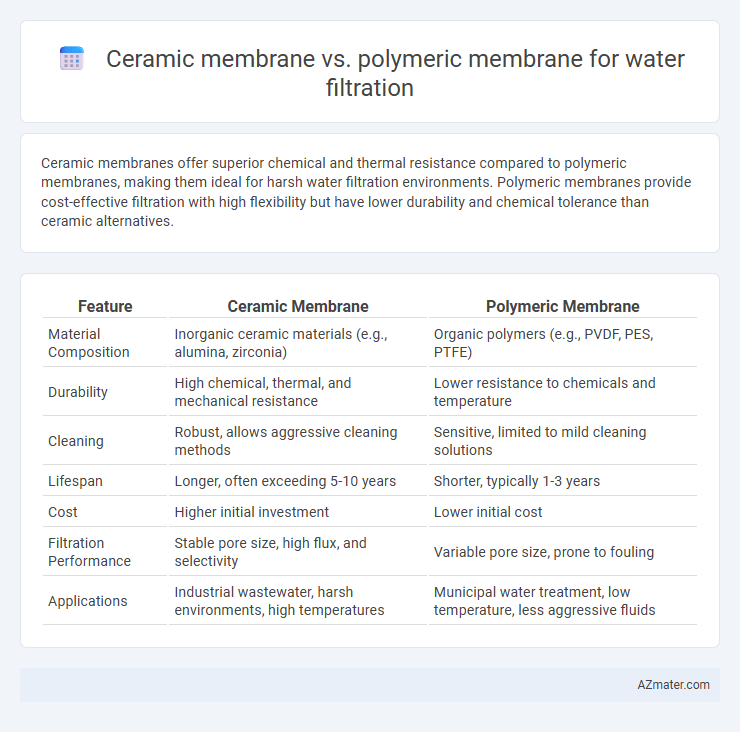Ceramic membranes offer superior chemical and thermal resistance compared to polymeric membranes, making them ideal for harsh water filtration environments. Polymeric membranes provide cost-effective filtration with high flexibility but have lower durability and chemical tolerance than ceramic alternatives.
Table of Comparison
| Feature | Ceramic Membrane | Polymeric Membrane |
|---|---|---|
| Material Composition | Inorganic ceramic materials (e.g., alumina, zirconia) | Organic polymers (e.g., PVDF, PES, PTFE) |
| Durability | High chemical, thermal, and mechanical resistance | Lower resistance to chemicals and temperature |
| Cleaning | Robust, allows aggressive cleaning methods | Sensitive, limited to mild cleaning solutions |
| Lifespan | Longer, often exceeding 5-10 years | Shorter, typically 1-3 years |
| Cost | Higher initial investment | Lower initial cost |
| Filtration Performance | Stable pore size, high flux, and selectivity | Variable pore size, prone to fouling |
| Applications | Industrial wastewater, harsh environments, high temperatures | Municipal water treatment, low temperature, less aggressive fluids |
Introduction to Water Filtration Membranes
Ceramic membranes and polymeric membranes are fundamental components in water filtration systems, each offering unique material properties that influence performance and durability. Ceramic membranes exhibit high chemical and thermal stability, making them suitable for harsh water treatment environments, while polymeric membranes provide flexibility and cost-effectiveness for diverse filtration applications. Selection between ceramic and polymeric membranes depends on specific treatment goals, water quality, and operational conditions in water filtration processes.
Overview of Ceramic Membranes
Ceramic membranes in water filtration offer superior chemical resistance, thermal stability, and longevity compared to polymeric membranes, making them ideal for harsh industrial applications. These membranes typically consist of materials like alumina, zirconia, or titania, providing high permeability and excellent fouling resistance. Their robustness allows for aggressive cleaning methods, ensuring consistent performance in filtering suspended solids, bacteria, and viruses in both municipal and industrial wastewater treatment.
Overview of Polymeric Membranes
Polymeric membranes, widely used in water filtration, consist primarily of materials such as polysulfone, polyethersulfone, and polyvinylidene fluoride (PVDF), known for their flexibility and cost-effectiveness. These membranes offer high permeability and chemical resistance, making them suitable for ultrafiltration, microfiltration, and nanofiltration processes in municipal and industrial water treatment. However, polymeric membranes typically exhibit lower thermal stability and shorter lifespan compared to ceramic membranes, requiring careful operational management to prevent fouling and degradation.
Filtration Mechanisms: Ceramic vs Polymeric
Ceramic membranes utilize a rigid micro-porous structure that enables precise separation through size exclusion and electrostatic interactions, offering high thermal and chemical resistance for aggressive water treatment applications. Polymeric membranes primarily rely on polymer chain matrix sieving and surface adsorption, providing flexibility and cost-effectiveness but with lower tolerance to harsh cleaning agents and extreme pH conditions. The filtration mechanisms of ceramic membranes result in longer service life and superior fouling resistance compared to polymeric membranes, making them ideal for industrial wastewater and high-temperature filtration processes.
Performance and Efficiency Comparison
Ceramic membranes demonstrate superior chemical resistance and thermal stability, enabling higher tolerance to extreme pH levels and temperatures than polymeric membranes, which enhances their longevity and reduces fouling. Polymeric membranes typically offer higher permeability and lower initial cost but suffer from limited durability and greater susceptibility to chlorine degradation. Ceramic membranes achieve greater flux recovery rates after cleaning, making them more efficient in long-term water filtration applications with minimal performance decline.
Durability and Lifespan
Ceramic membranes demonstrate superior durability and longer lifespan compared to polymeric membranes due to their high resistance to chemical, thermal, and mechanical stress. Their robust structure enables extended use in harsh water filtration environments without significant degradation or fouling. Polymeric membranes, while more flexible and cost-effective, often have shorter operational lifespans because they are prone to damage from oxidation, microbial attack, and temperature fluctuations.
Chemical and Thermal Resistance
Ceramic membranes exhibit superior chemical resistance, withstanding aggressive solvents, acids, and alkalis without degradation, making them ideal for harsh water filtration applications. Their thermal stability allows operation at temperatures exceeding 300degC, unlike polymeric membranes, which typically degrade above 60-80degC. Polymeric membranes, while flexible and cost-effective, are limited by lower resistance to chemicals and heat, restricting their use in high-temperature or corrosive environments.
Cost Analysis and Economic Considerations
Ceramic membranes typically have higher initial capital costs compared to polymeric membranes due to advanced materials and manufacturing complexity, but offer longer lifespan and lower replacement frequency, leading to reduced long-term operational expenses. Polymeric membranes are more cost-effective upfront and widely used in municipal and industrial water treatment, yet they often incur higher maintenance and replacement costs due to fouling and degradation. Economic considerations must balance ceramic membranes' durability and thermal resistance advantages against polymeric membranes' affordability and widespread availability to optimize total cost of ownership in water filtration applications.
Environmental Impact and Sustainability
Ceramic membranes offer superior environmental sustainability due to their longer lifespan and higher chemical and thermal resistance, reducing waste and replacement frequency compared to polymeric membranes. Polymeric membranes, while often less energy-intensive to produce, tend to degrade faster, generating more plastic waste and requiring frequent disposal and replacement. The recyclability and durability of ceramic membranes contribute significantly to minimizing the overall ecological footprint in water filtration processes.
Applications and Industry Use Cases
Ceramic membranes excel in high-temperature and chemically aggressive environments, making them ideal for industrial wastewater treatment, food and beverage processing, and pharmaceutical manufacturing where durability and chemical resistance are crucial. Polymeric membranes are widely used in municipal water treatment, desalination, and residential filtration systems due to their cost-effectiveness and flexibility for large-scale applications. Industries requiring high-purity filtration with resistance to fouling prefer ceramic membranes, while polymeric membranes dominate sectors prioritizing low initial investment and ease of membrane replacement.

Infographic: Ceramic membrane vs Polymeric membrane for Water filtration
 azmater.com
azmater.com